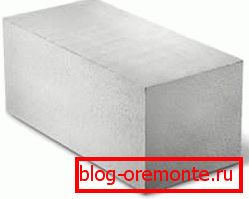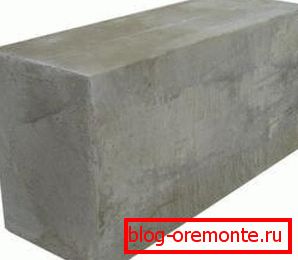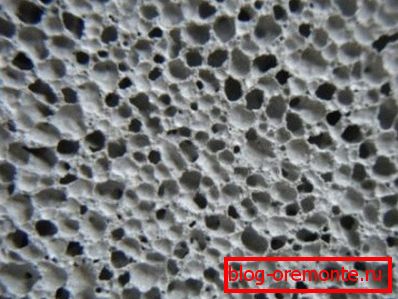Aerated concrete blocks and their features
Cellular concrete is an artificial porous material made of a mineral binder component and silica fillers. Blocks of cellular concrete according to GOST 31360 2007 can be used both as a warming and structural material. Next, we take a closer look at their features and applications.

What is cellular concrete
Many people are confused in such concepts as “cellular concrete”, “foam concrete”, “gas concrete” and “gas silicate”. Some believe that this is the same material, while others - on the contrary, they are completely different materials.
In reality, neither are right. Cellular concrete is a whole group of materials that is united by a common property that is displayed in the title - their thickness is filled with evenly distributed pore cells. As a result, the density of the structure decreases.

According to the method of formation, porous concretes are divided into two groups:
- Gas concrete - pores are formed as a result of processing the composition in an autoclave.
- Foam concrete - the formation of pores occurs as a result of foaming of the solution and solidification under natural conditions.
I must say that the price of foam concrete is slightly lower than aerated concrete. But for the fact, aerated concrete is somewhat stronger. But, in general, their properties are very similar.

Material Features
Properties
Blocks of cellular concrete have a number of advantages, among which are the following points:
| Ease with large dimensions |
|
| Good thermal insulation properties | A wall of porous blocks 400-600 mm thick corresponds to a brick wall 1500 mm thick. These properties allow you to save energy. |
| Ease of processing | If professional equipment with diamond nozzles is used for processing traditional reinforced concrete, for example, cutting of reinforced concrete with diamond circles or diamond drilling of holes in concrete is carried out, then processing of porous concrete can be performed with the most common tool. For example, it is not difficult to cut it with a regular hacksaw. |
| Frost resistance | The material can withstand up to fifty cycles of freezing and thawing, and some of its types and more. |
| Fire safety | The material not only does not burn, but also prevents the spread of fire. Therefore, it can be used for all classes of fire safety. |
| Environmental friendliness |
|
Note! Since the material has a high level of vapor permeability, wall decoration should also have this property.
As for the negative aspects, they include insufficient strength for the construction of foundations and other structures, which implies a large load on the walls. In addition, some types of blocks require waterproofing as a result of through pores.

Specifications
Characteristics of cellular concrete blocks largely depend on its brand. Next, we consider the main characteristics of the most common brands:
| Options | M600 | M500 |
| Strength | 29-36 kgf / cm2 | 22-28 kgf / cm2 |
| Density | 575-625 kg / m3 | 475-525 kg / m3 |
| Thermal conductivity | 0.14 W / ms | 0.12 W / ms |
| Shrinkage | 0.4 mm / m | 0.4 mm / m |
Blocks of cellular concrete in accordance with GOST 21520 89 should be made of concrete with compressive strength not lower than M25, and their density should not exceed D1200. Release moisture should be no more than 25 percent.
The dimensions of the aerated concrete blocks are regulated by the aforementioned GOST and there are 10 types. However, at the request of the customer, the dimensions can be changed.

Application area
Initially, cellular concrete blocks were produced as a heat-insulating material, as well as for the construction of internal partitions. However, recently they are used as a structural material.
In particular, they are actively used for the following purposes:
- For masonry internal and external walls, as well as partitions in the construction of multi-storey buildings of frame type.
- When building 1-3 storey houses and cottages.
- When building garages and outbuildings.

Laying features
As already mentioned above, it is simpler to do the laying with your own hands from the considered blocks than, for example, from brick.
The only thing before you start work, you need to familiarize yourself with the following nuances:
- Before laying the material, it is necessary to perform horizontal waterproofing of the foundation.
- When building masonry, as a rule, use a special glue for blocks of cellular concrete. Its use will reduce the seams between the blocks and thereby increase the insulating properties of the walls.
- Every 3-4 rows must be reinforced with two metal rods with a diameter of 8 mm, for which special recesses are made.
- To perform stiffeners, for example, under the overlap, U-shaped blocks should be used, which are reinforced and poured with concrete.
Tip! If the wall will be finished with plaster from two sides, then during the construction of the masonry vertical joints can not be filled with mortar.
The rest of the instructions for the construction of masonry is the same as when working with bricks and other similar materials.
Conclusion
Blocks of cellular concrete are modern building materials with many advantages. The only thing is, when using them, it is necessary to choose the right type of material to match the operating conditions, as well as to follow the technology of masonry construction (also learn how to make a septic tank from concrete rings).
From the video in this article, you can get more information on this topic.